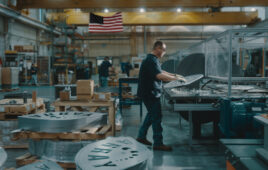
By: Christopher Barrett, APsystems
Solar power is gaining a coalition of fans, their numbers growing as PV spreads around the globe. But many emergency responders aren’t yet sold, and understandably so. They, and others, are concerned with the electrical safety of these new and often unfamiliar systems. The idea of high-voltage DC sizzling across a rooftop is a stark prospect for anyone who might come in contact with a PV array while battling a building fire, or even performing routine maintenance.
Seeing the need for safety standards, regulators enacted “Rapid Shutdown” requirements (found in NEC 2014 690.12) to protect first responders from any high-voltage DC hazards that might remain after AC service has been disrupted or shut off. While manufacturers have responded to NEC 2014 with varying strategies–including add-on “DC combiner boxes” for string inverter arrays–one popular PV product already has Rapid Shutdown built into every unit: the microinverter.
When the AC circuit goes down for any reason, each unit in a microinverter array performs its own shutdown function in just 100 milliseconds–100 times faster than the code-specified standard of 10 seconds for shutdown.System voltage at shutdown is about 30V DC, meeting the stringent NEC 2014 requirement and well below the 80-V threshold generally considered safe for contact.
 Safety doesn’t end there. Microinverters also offer safety advantages when it comes to the DC conductor requirement in the standard. For example, a system designed using APsystems microinverters will have no DC conductors energized more than 5 ft in length within a building or more than 10 ft from the array, which meets the NEC 2014 standard (and is already looking ahead to NEC 2017).
Safety doesn’t end there. Microinverters also offer safety advantages when it comes to the DC conductor requirement in the standard. For example, a system designed using APsystems microinverters will have no DC conductors energized more than 5 ft in length within a building or more than 10 ft from the array, which meets the NEC 2014 standard (and is already looking ahead to NEC 2017).
Also, any present low-voltage lines will be located beneath solar modules, eliminating the chance of contact during rooftop activity.
Powerful, reliable, economical, microinverters have had plenty to recommend them since they entered the MLPE product field. As electrical codes evolve to protect responders and homeowners alike, the humble microinverter is not only meeting these tough new standards, but anticipating them.
By: Christopher Barrett, engineering and technical services manager for APsystems USA. Contact him at christopher.barrett@apsystems.com.
To learn more, watch his webinar presentation here.





Tell Us What You Think!